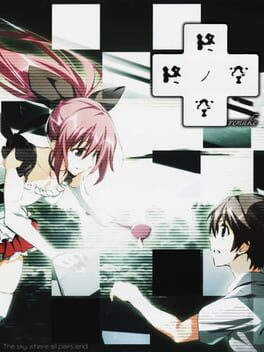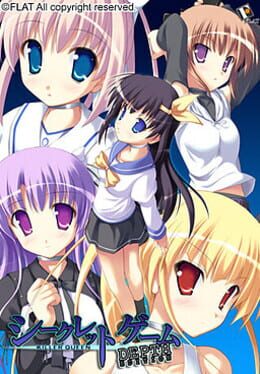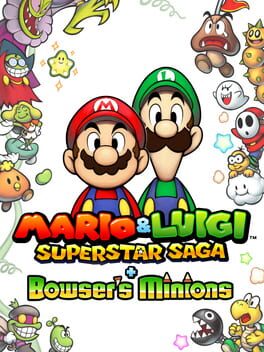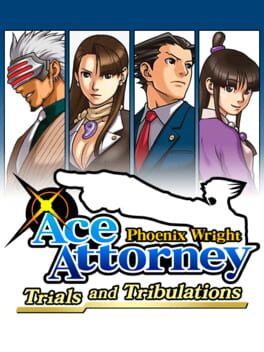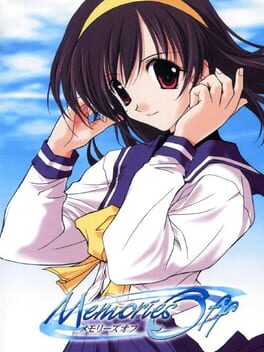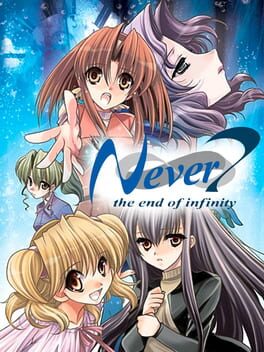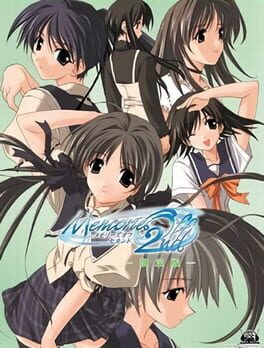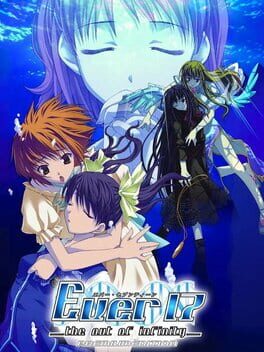Phantom0
5 reviews liked by Phantom0
Tsui no Sora Remake
2020
Considering I've already written over 7,000 words on the original Tsui no Sora on this site, I intend to keep things a little shorter for now. My intentions below are to both discuss some route-by-route feelings in comparison to the original game, as well as further ruminate on the philosophical and thematic elements of both Tsui no Sora and Subarashiki Hibi. I'll give a spoiler warning when we jump full-on into dangerously heavy spoiler territory below. Still, mild spoilers for all three games within.
I don't think you need to have played the original game to appreciate the remake, you certainly need Subahibi, though. The original is helpful for understanding some of the deliberate deviations the remake gets at, some of which are pretty major, but you could feasibly play this with just Subahibi under your belt and get 85% of the point. It's hard to image what sort of impression the remake would land if not taken as an addition to the previous iterations of this story. I think above all else, SCA-Ji was able to more directly address additional influences over the original Tsui no Sora in the remake. Not only did he buckle down and more directly address the most obvious influence, being Nietzsche and particularly Zarathustra, but the influences of Spinoza and Lovecraft are even more clearly dug into and elaborated upon here in ways that are rewarding if you've spent time thinking about Subahibi for as long as many of us have.
Presentation-wise, the remake is a very interesting hodgepodge of KeroMakura styles and talents. Motoyon and SCA-Ji both take lead artistic roles here, and while SCA-Ji very much still draws in the same style he has since around the H2O and Subahibi days, Motoyon was clearly already adjust his style for the upcoming Sakura no Toki and so it comes off much more modernized. Motoyon also did most of the CGs, which are absolutely beautiful. Rarely as abstract as some of Subahibi's, but beautiful nontheless.
This sort of disorientation is largely supplemented by the fact that many background elements are ripped right from Subahibi, and the soundtrack is pretty much all the original ~15 second loops from the original Tsui no Sora. ... Until this isn't the case from Fourth View onwards, where elements of Subahibi begin to melt in from the soundtrack to a few pieces of CGs. The voice cast is largely different, and the only people who reprise their roles from Subarashiki Hibi do so with intent. Largely great performances all around. Each of the ending themes is an instrumental remix of one of the Tsui no Sora tracks and they're all fantastic. I think my favorites were Third View and Numinöse II.
On a route by route basis -
First View was a bit different from the original, largely in how it characterizes Yukito. I really liked the more grounded and empathetic view of his character this time around, and I wouldn't say it "replaces" the original because they're largely coming from places with different intentions. Otherwise, note for note, extremely faithful to the original everywhere it should've been. Second View was definitely interesting. There were a few moments of characterization missing that I loved in the original, even if they were small beats, and at first I wasn't sure how I felt about it. But once the plot started ramping up and the big deviations from the original plotline kicked in, largely revolving around Yasuko's feelings towards Kotomi I ended up absolutely loving it. Despite some minor nitpicks in the first half it's absolutely a stronger version of this story line. I have little in the way of notes for Third Route. It's just a straight up improvement over the original in every way. Admittedly cried to the ending.
... And that's where things got really interesting.
Massive spoilers for the remake and Subarashiki Hibi below.
I had heard tell that Yasuko of all characters was the protagonist of a new route in the remake, but somehow I wasn't expecting it to be earlier in the game than Takuji. I also wasn't expecting it to be arguably the best part of the game. She's simply one of SCA-Ji's best characters I've yet to experience. A deeply morally conflicting character who scratches directly at the wound that plagues every iteration of this story - the incessant babbling about existentialism and purposelessness of life means nothing in the face of love. And Yasuko is a character who has had her humanity stripped from her by force - but still clings to the subconscious believe that love is worth fighting for. You can say she's really fucked up for how she tries to get with Kotomi and you're definitely right, but by the end of the route, when she and Kiyoshi just get to have that heart to heart... shit, man, that's the point of the whole story. That's what each version of this game has been trying to say since 1999. Even if SCA-Ji himself couldn't have put it into words yet.
Final View was certainly interesting. I really loved that some of the abstract visions from the original game were left intact, 1999 artwork against 2010 backgrounds and all. I also really enjoyed how much Takuji and Riruru were given time to expand upon their relationship to one another. One of the strongest elements of the remake's stab at this story is how much it points its cast in the direction of "reality of the heart". In the same way that Yasuko had to come to terms with her feelings for Kotomi, Takuji has to do the same for Yukito - the nature of those feelings may be vague, but I chose to interpret it as an attraction of the mind. Maybe there's some homo-eroticism in there and I wouldn't deny that, but I think it's more that Takuji sees a home and a place of understanding in Yukito. I'm... gonna have to sit with the moment he hears Kimika's voice and unbox why that was for a minute. It's the most confounding and jaw-dropping moment in the entire route and it's gone within a second. Again, there are a few minor things I do miss from the original, especially some of the more abstract denpa effects like Riruru's number spiral form or the eyeball bleeding into the pool, but this version of Final View has many aspects that undeniably surpass the original and at the very least do the series as a whole serious justice.
And then there's the Numinöse duology. Numinöse I seems largely unchanged from the original, but that's fine - I already like that ending more than most. Numinöse II has some interesting changes itself, and the duology as a whole stands as a rather interesting conclusion to the series overall. I'm happy that SCA-Ji keeps it vague and never actually explains what Ayana is. The Nyarlathotep explanation is an interesting proposition, the Cthulhu explanation is also interesting, and the way she molds and shifts around her necessities and whims, or those of others... all interesting. As far as where I stand on Ayana, and the purpose of the End Sky itself? Well...
First off, it was incredibly gratifying to get SCA-Ji backing me up on my original read of what the End Sky represents - it's the doorway to an Übermenschian evolution, the discarding of humanity and subjectivity to become, as Riruru and Ayana put it, a "third-dimensional existence". I think this is the purpose of Yasuko saying what she does on the rooftop to Takuji - to discard humanity is to discard our ability to love, because love is founded in perception and irrational thought. It's not so much that the End Sky exists, or that it doesn't - it appears in many ways to many people, as an escape, as an evolution, as an ending. Perhaps that's why Kimika's voice reaches Takuji in the end, as a reminder that he is human, and is capable of a love that transcends his own delusions. I've said it before, and I'll say it again - Down the Rabbit-Hole I and the "good endings" of Subahibi are the entire point. They're the response SCA-Ji makes to himself and his work in Tsui no Sora, and now he's returned to this early work and planted seeds of that answer into the bleak and hopeless place he left behind in 1999. I do believe the only presence that actually does sit above humanity in all of this is Ayana - who is more of an idea than a tangible thing. I think you can rationalize that existence many ways: a monster, a schoolgirl, a cosmic terror, a god, a magical girl - but ultimately, Ayana is objectivity. She is the third-dimensional existence that plays out stories and creates scenarios for the purpose of understanding humanity. And if it's not directly her doing - though clarity on that isn't really necessary - then she's merely observing. It's not that she's cold, it's not that she's cruel, feelings just don't process for her. It's all an imitation or an attempt to emulate expression. But that begs the question, which she asks Yasuko - what's the difference in attempting to understand and engage with human emotion and actually having those emotions, considering neither exist on the plane of logical thinking or rationality either way? Where does the line blur between emulation and experience? Fantasy and reality? Truth or feelings? An ending or a beginning? Takuji or Yukito? Ayana or Kotomi? The End Sky. The unreachable all-knowingness that we seek in spite of its non-existence. Human ambition. Yearning to understand. Indulgence in sophistry. The answer was already in front of us. Live happily in the wonderful everyday.
SCA-Ji is the fucking man. That's the be-all-end-all of this whole thing.
I don't think you need to have played the original game to appreciate the remake, you certainly need Subahibi, though. The original is helpful for understanding some of the deliberate deviations the remake gets at, some of which are pretty major, but you could feasibly play this with just Subahibi under your belt and get 85% of the point. It's hard to image what sort of impression the remake would land if not taken as an addition to the previous iterations of this story. I think above all else, SCA-Ji was able to more directly address additional influences over the original Tsui no Sora in the remake. Not only did he buckle down and more directly address the most obvious influence, being Nietzsche and particularly Zarathustra, but the influences of Spinoza and Lovecraft are even more clearly dug into and elaborated upon here in ways that are rewarding if you've spent time thinking about Subahibi for as long as many of us have.
Presentation-wise, the remake is a very interesting hodgepodge of KeroMakura styles and talents. Motoyon and SCA-Ji both take lead artistic roles here, and while SCA-Ji very much still draws in the same style he has since around the H2O and Subahibi days, Motoyon was clearly already adjust his style for the upcoming Sakura no Toki and so it comes off much more modernized. Motoyon also did most of the CGs, which are absolutely beautiful. Rarely as abstract as some of Subahibi's, but beautiful nontheless.
This sort of disorientation is largely supplemented by the fact that many background elements are ripped right from Subahibi, and the soundtrack is pretty much all the original ~15 second loops from the original Tsui no Sora. ... Until this isn't the case from Fourth View onwards, where elements of Subahibi begin to melt in from the soundtrack to a few pieces of CGs. The voice cast is largely different, and the only people who reprise their roles from Subarashiki Hibi do so with intent. Largely great performances all around. Each of the ending themes is an instrumental remix of one of the Tsui no Sora tracks and they're all fantastic. I think my favorites were Third View and Numinöse II.
On a route by route basis -
First View was a bit different from the original, largely in how it characterizes Yukito. I really liked the more grounded and empathetic view of his character this time around, and I wouldn't say it "replaces" the original because they're largely coming from places with different intentions. Otherwise, note for note, extremely faithful to the original everywhere it should've been. Second View was definitely interesting. There were a few moments of characterization missing that I loved in the original, even if they were small beats, and at first I wasn't sure how I felt about it. But once the plot started ramping up and the big deviations from the original plotline kicked in, largely revolving around Yasuko's feelings towards Kotomi I ended up absolutely loving it. Despite some minor nitpicks in the first half it's absolutely a stronger version of this story line. I have little in the way of notes for Third Route. It's just a straight up improvement over the original in every way. Admittedly cried to the ending.
... And that's where things got really interesting.
Massive spoilers for the remake and Subarashiki Hibi below.
I had heard tell that Yasuko of all characters was the protagonist of a new route in the remake, but somehow I wasn't expecting it to be earlier in the game than Takuji. I also wasn't expecting it to be arguably the best part of the game. She's simply one of SCA-Ji's best characters I've yet to experience. A deeply morally conflicting character who scratches directly at the wound that plagues every iteration of this story - the incessant babbling about existentialism and purposelessness of life means nothing in the face of love. And Yasuko is a character who has had her humanity stripped from her by force - but still clings to the subconscious believe that love is worth fighting for. You can say she's really fucked up for how she tries to get with Kotomi and you're definitely right, but by the end of the route, when she and Kiyoshi just get to have that heart to heart... shit, man, that's the point of the whole story. That's what each version of this game has been trying to say since 1999. Even if SCA-Ji himself couldn't have put it into words yet.
Final View was certainly interesting. I really loved that some of the abstract visions from the original game were left intact, 1999 artwork against 2010 backgrounds and all. I also really enjoyed how much Takuji and Riruru were given time to expand upon their relationship to one another. One of the strongest elements of the remake's stab at this story is how much it points its cast in the direction of "reality of the heart". In the same way that Yasuko had to come to terms with her feelings for Kotomi, Takuji has to do the same for Yukito - the nature of those feelings may be vague, but I chose to interpret it as an attraction of the mind. Maybe there's some homo-eroticism in there and I wouldn't deny that, but I think it's more that Takuji sees a home and a place of understanding in Yukito. I'm... gonna have to sit with the moment he hears Kimika's voice and unbox why that was for a minute. It's the most confounding and jaw-dropping moment in the entire route and it's gone within a second. Again, there are a few minor things I do miss from the original, especially some of the more abstract denpa effects like Riruru's number spiral form or the eyeball bleeding into the pool, but this version of Final View has many aspects that undeniably surpass the original and at the very least do the series as a whole serious justice.
And then there's the Numinöse duology. Numinöse I seems largely unchanged from the original, but that's fine - I already like that ending more than most. Numinöse II has some interesting changes itself, and the duology as a whole stands as a rather interesting conclusion to the series overall. I'm happy that SCA-Ji keeps it vague and never actually explains what Ayana is. The Nyarlathotep explanation is an interesting proposition, the Cthulhu explanation is also interesting, and the way she molds and shifts around her necessities and whims, or those of others... all interesting. As far as where I stand on Ayana, and the purpose of the End Sky itself? Well...
First off, it was incredibly gratifying to get SCA-Ji backing me up on my original read of what the End Sky represents - it's the doorway to an Übermenschian evolution, the discarding of humanity and subjectivity to become, as Riruru and Ayana put it, a "third-dimensional existence". I think this is the purpose of Yasuko saying what she does on the rooftop to Takuji - to discard humanity is to discard our ability to love, because love is founded in perception and irrational thought. It's not so much that the End Sky exists, or that it doesn't - it appears in many ways to many people, as an escape, as an evolution, as an ending. Perhaps that's why Kimika's voice reaches Takuji in the end, as a reminder that he is human, and is capable of a love that transcends his own delusions. I've said it before, and I'll say it again - Down the Rabbit-Hole I and the "good endings" of Subahibi are the entire point. They're the response SCA-Ji makes to himself and his work in Tsui no Sora, and now he's returned to this early work and planted seeds of that answer into the bleak and hopeless place he left behind in 1999. I do believe the only presence that actually does sit above humanity in all of this is Ayana - who is more of an idea than a tangible thing. I think you can rationalize that existence many ways: a monster, a schoolgirl, a cosmic terror, a god, a magical girl - but ultimately, Ayana is objectivity. She is the third-dimensional existence that plays out stories and creates scenarios for the purpose of understanding humanity. And if it's not directly her doing - though clarity on that isn't really necessary - then she's merely observing. It's not that she's cold, it's not that she's cruel, feelings just don't process for her. It's all an imitation or an attempt to emulate expression. But that begs the question, which she asks Yasuko - what's the difference in attempting to understand and engage with human emotion and actually having those emotions, considering neither exist on the plane of logical thinking or rationality either way? Where does the line blur between emulation and experience? Fantasy and reality? Truth or feelings? An ending or a beginning? Takuji or Yukito? Ayana or Kotomi? The End Sky. The unreachable all-knowingness that we seek in spite of its non-existence. Human ambition. Yearning to understand. Indulgence in sophistry. The answer was already in front of us. Live happily in the wonderful everyday.
SCA-Ji is the fucking man. That's the be-all-end-all of this whole thing.
i might be a psychopath for rating it this high but this game is just peak for me. all about the characters and their relationships and the tension that comes from the scenario, rather than being About the scenario. absolutely goated
full thoughts/sales pitch for this game (you should play it): https://lonesgamethoughts.blogspot.com/2022/04/rebellions-review-just-trust-me-you-guys.html
full thoughts/sales pitch for this game (you should play it): https://lonesgamethoughts.blogspot.com/2022/04/rebellions-review-just-trust-me-you-guys.html
I've always wanted to play through the Mario & Luigi series in full, but never got around to it. The only one I ever played in full was Bowser's Inside Story, which I loved to death, but I bounced off Partners in Time (which I plan to give another chance soon) and was also put off the original Superstar Saga due to its more limited hardware and lack of Quality of Life changes the other games on DS/3DS had, so I just watched Lucahjin's LP of it growing up. But after finding out they made a 3DS remake of this game that seemingly addressed my issues with the original, I wanted to play this as the start of my full Mario & Luigi series binge. I was very lucky and glad to have my kind friend Zach give me his copy of the game as he was no longer playing it.
Before I start my review properly, I want to preface this by saying that I'm honestly really upset people completely dismissed this remake just because of complaints like "omg, they made the bean bean citizen sprites more generic! this game sucks now" and "omg, the art style looks so much more sterile". Let's all be honest here, NO ONE plays these games for the NPCs, and if you say that, you're a bad liar. If you actually want good unique NPCs in an RPG, go play Trails in the Sky or something. Secondly, the art style, while uniform with Dream Team's sprite style, still has a TON of heart and love put into it and still looks really good. The animations here look so fluid and even more bombastic than they did in the original Superstar Saga on GBA. (And personally, I prefer how Bowser looks here, I thought he looked cute in the original game but it didn't really fit him.)
Anyway, I'll start off this review proper by talking about the really great Quality of Life additions they made to this game. First, I love that they added a fast forward button to cutscenes since you can't skip them, really helpful in saving time. Not only that, you can even use the touch screen to fast forward in case your R button doesn't work! Very helpful given that R Buttons on DS/3DS wear down the fastest on average and stop working altogether, great job Alphadream.
The fact that now you can place down markers on the map for points of interest were really helpful too, helped me get 100% of the items by going back to spots I would've normally totally forgotten about with later abilities. The new ability to jump with both Bros at the same time by pressing X is super useful for not having to swap back to the normal Jump Ability all the time and also helps make certain minigames easier. Another welcome change is how you can more easily practice Bros Attacks by seeing Practice Demos of how they're supposed to be performed and practicing them yourself without reprecussion instead of having to waste BP to try to master them. And last but not least, all of the tutorials are shoved into this toggleable Guide option and not shoved into your face with constant text anymore, which helps save time for veteran players and is very much appreciated. These are all great QoL changes that help make the experience much more smooth and fun, on top of Superstar Saga now having a dual screen to work with for the map, and the additional Y and X buttons for other things like what I've mentioned above, very nice.
As for the story, it's what you'd expect from this great series, very charming and fun, the characters are all hilarious and bounce off each other in fun ways. Something unique to this game that I wish the later games hadn't stopped doing is how you don't have some info dump partner character handhold guiding Mario and Luigi every step of the way (like Starlow), so they have to figure out things by themselves with their silent Show Don't Tell portrayals, which I like a lot more, it's very charming and cute.
This part isn't really a critique, but man, I'd forgotten how much Bowser gets dunked on in this game. The guy's Koopa Cruiser is obliterated Day 1, he gets amnesia from his own minion hitting him in the head, becomes a pathetic thief's lackey, then gets possessed by the big bad, only to get saved but then splat into the screen and trapped in a present box and dropped from the sky back into his Castle. Thankfully, AlphaDream more than made up for this by making Inside Story, which I imagine was partially an apology to Bowser fans for completely disrespecting him in this game, haha.
The gameplay is also better than ever, the more fluid Sprite Animations make it a lot easier to see how attacks are telegraphed, and the additional Emergency Guard option is also a nice QoL addition if you can't get doding an attack down. I love how much the Bros Attacks really feel like the Bros working in perfect sync, and how using them a lot gives you unique additional versions of them too, though I'm curious in seeing how later games evolve them (or not, given what I've heard, but I hope I'm wrong).
The game's difficulty is pretty easy for the most part, the only real boss fights I had any trouble with was the first Cackletta Fight and the final boss. That said, it works in the game's favor. The fact you don't struggle against most of the bosses means you get to stock up items hard throughout this game, which is a good thing because holy crap, you will NEED THEM for the final dungeon. The final dungeon is such a big difficulty spike with challenging bosses, culminating in the final boss being really difficult. That said, I was 6 levels underleveled for the final boss (the final boss being level 40), which is definitely why it bodied me. I managed to beat it in one try but holy crap it took everything I had and took about an hour and a half total, if I wasn't used to action games and had a million healing items stocked up, I wouldn't have won. It was a really fun challenge that put all of my skills at Mario & Luigi to the ultimate test, and I'll definitely remember the fight fondly, but wow would this be pretty unfun for a lot of people who aren't ready for it. It's definitely a fight the casual player will want to be at the right level for with good equipment. I hear they did fix the final boss to not have nearly as much ridiculously high HP as the original game did, which I'm glad for. When I refought the final boss at the proper level, it went down in a reasonable amount of time (pretty quickly actually), so I think that's very fair.
Speaking of, I would recommend using amiibo for this game if possible, as they can net you the #1 Trousers which are very helpful. They gave Mario super high speed early in the game, and with the various Overall Equipment for Luigi that make him go after Mario immediately in turn order, it helped me stay ahead of the curve enemy wise. I'd also recommend doing all the mini games for all the beans you can get up until you get to Beanbean Castle Town because they will help you get all the E. Gadd rewards quickly which help cut down on backtracking and help you get the best rewards in the game pretty early, which is super helpful. Definitely makes the final boss a lot more doable too.
To touch back on the characters real quick, while I don't really find Fawful or Cackletta that funny like I did when I watched the Superstar Saga LP when I was younger, they serve their purpose well enough, and the charm of Mario & Luigi and their supporting cast more than make up for it, plus it's nice to see the villain duo get put in their place after all the mischief they made throughout the game.
The OST in this game is also fantastic, as per the usual M&L standard. You can't really ever go wrong with Yoko Shimomura's amazing music, and I really like the better instrumentation for the OST here compared to the GBA, it's more higher quality and feels like it better lets Yoko express what she wanted to with the original limited GBA soundchip.
Lastly, I'll touch upon the Bowser's Minion Mode. It's all right, it can get pretty repetitive and isn't super interactive until later on, but I found it's actually great to play when multitasking (I watched videos on my Youtube Backlog while playing it), which was nice. I actually did like the story of it a lot, with a lone Goomba rising up to become one of Bowser's most capable and loyal minions, and I was actually surprised how invested I became in his endearing journey, the story was pretty cool and it was nice seeing more fleshing out of Bowser's Minion cast behind the scenes of the main story. That said, I'd probably be more likely to tell people to just watch the cutscenes on Youtube than play through the mode, since it can be a bit of a slog. I still liked it enough to 100% the mode, but that's only because I liked this game a lot period and wanted to see everything it had to offer.
Overall, this game is a very nice feels good game that's incredibly fun, and not too long (if you just do the main story and maybe get all the items). I loved it enough to 100% the main story by getting every item, doing all the mini games, and even 100%ing the bonus mode, though I definitely will say I'll never 100% it again since it was a bit grating to get everything near the end and I'm definitely burnt out for the time being. That said, this game is definitely one I look forward to replaying sometime in the future for a casual run where I just beat the main story at my own pace without trying to do everything. A worthy remake of the first M&L title that I'd recommend over the GBA to anyone willing to give it a chance, I hope more people get to play it someday.
(Last thing, but the credits theme made me tear up a bit, since it's a very great ending song that reminded me this was one of the last games AlphaDream ever made before going bankrupt. Rest in peace you wonderful company that made such great games.)
Final Playtime (according to 3DS Playtime Activity): 49 hours, 5 minutes.
Before I start my review properly, I want to preface this by saying that I'm honestly really upset people completely dismissed this remake just because of complaints like "omg, they made the bean bean citizen sprites more generic! this game sucks now" and "omg, the art style looks so much more sterile". Let's all be honest here, NO ONE plays these games for the NPCs, and if you say that, you're a bad liar. If you actually want good unique NPCs in an RPG, go play Trails in the Sky or something. Secondly, the art style, while uniform with Dream Team's sprite style, still has a TON of heart and love put into it and still looks really good. The animations here look so fluid and even more bombastic than they did in the original Superstar Saga on GBA. (And personally, I prefer how Bowser looks here, I thought he looked cute in the original game but it didn't really fit him.)
Anyway, I'll start off this review proper by talking about the really great Quality of Life additions they made to this game. First, I love that they added a fast forward button to cutscenes since you can't skip them, really helpful in saving time. Not only that, you can even use the touch screen to fast forward in case your R button doesn't work! Very helpful given that R Buttons on DS/3DS wear down the fastest on average and stop working altogether, great job Alphadream.
The fact that now you can place down markers on the map for points of interest were really helpful too, helped me get 100% of the items by going back to spots I would've normally totally forgotten about with later abilities. The new ability to jump with both Bros at the same time by pressing X is super useful for not having to swap back to the normal Jump Ability all the time and also helps make certain minigames easier. Another welcome change is how you can more easily practice Bros Attacks by seeing Practice Demos of how they're supposed to be performed and practicing them yourself without reprecussion instead of having to waste BP to try to master them. And last but not least, all of the tutorials are shoved into this toggleable Guide option and not shoved into your face with constant text anymore, which helps save time for veteran players and is very much appreciated. These are all great QoL changes that help make the experience much more smooth and fun, on top of Superstar Saga now having a dual screen to work with for the map, and the additional Y and X buttons for other things like what I've mentioned above, very nice.
As for the story, it's what you'd expect from this great series, very charming and fun, the characters are all hilarious and bounce off each other in fun ways. Something unique to this game that I wish the later games hadn't stopped doing is how you don't have some info dump partner character handhold guiding Mario and Luigi every step of the way (like Starlow), so they have to figure out things by themselves with their silent Show Don't Tell portrayals, which I like a lot more, it's very charming and cute.
This part isn't really a critique, but man, I'd forgotten how much Bowser gets dunked on in this game. The guy's Koopa Cruiser is obliterated Day 1, he gets amnesia from his own minion hitting him in the head, becomes a pathetic thief's lackey, then gets possessed by the big bad, only to get saved but then splat into the screen and trapped in a present box and dropped from the sky back into his Castle. Thankfully, AlphaDream more than made up for this by making Inside Story, which I imagine was partially an apology to Bowser fans for completely disrespecting him in this game, haha.
The gameplay is also better than ever, the more fluid Sprite Animations make it a lot easier to see how attacks are telegraphed, and the additional Emergency Guard option is also a nice QoL addition if you can't get doding an attack down. I love how much the Bros Attacks really feel like the Bros working in perfect sync, and how using them a lot gives you unique additional versions of them too, though I'm curious in seeing how later games evolve them (or not, given what I've heard, but I hope I'm wrong).
The game's difficulty is pretty easy for the most part, the only real boss fights I had any trouble with was the first Cackletta Fight and the final boss. That said, it works in the game's favor. The fact you don't struggle against most of the bosses means you get to stock up items hard throughout this game, which is a good thing because holy crap, you will NEED THEM for the final dungeon. The final dungeon is such a big difficulty spike with challenging bosses, culminating in the final boss being really difficult. That said, I was 6 levels underleveled for the final boss (the final boss being level 40), which is definitely why it bodied me. I managed to beat it in one try but holy crap it took everything I had and took about an hour and a half total, if I wasn't used to action games and had a million healing items stocked up, I wouldn't have won. It was a really fun challenge that put all of my skills at Mario & Luigi to the ultimate test, and I'll definitely remember the fight fondly, but wow would this be pretty unfun for a lot of people who aren't ready for it. It's definitely a fight the casual player will want to be at the right level for with good equipment. I hear they did fix the final boss to not have nearly as much ridiculously high HP as the original game did, which I'm glad for. When I refought the final boss at the proper level, it went down in a reasonable amount of time (pretty quickly actually), so I think that's very fair.
Speaking of, I would recommend using amiibo for this game if possible, as they can net you the #1 Trousers which are very helpful. They gave Mario super high speed early in the game, and with the various Overall Equipment for Luigi that make him go after Mario immediately in turn order, it helped me stay ahead of the curve enemy wise. I'd also recommend doing all the mini games for all the beans you can get up until you get to Beanbean Castle Town because they will help you get all the E. Gadd rewards quickly which help cut down on backtracking and help you get the best rewards in the game pretty early, which is super helpful. Definitely makes the final boss a lot more doable too.
To touch back on the characters real quick, while I don't really find Fawful or Cackletta that funny like I did when I watched the Superstar Saga LP when I was younger, they serve their purpose well enough, and the charm of Mario & Luigi and their supporting cast more than make up for it, plus it's nice to see the villain duo get put in their place after all the mischief they made throughout the game.
The OST in this game is also fantastic, as per the usual M&L standard. You can't really ever go wrong with Yoko Shimomura's amazing music, and I really like the better instrumentation for the OST here compared to the GBA, it's more higher quality and feels like it better lets Yoko express what she wanted to with the original limited GBA soundchip.
Lastly, I'll touch upon the Bowser's Minion Mode. It's all right, it can get pretty repetitive and isn't super interactive until later on, but I found it's actually great to play when multitasking (I watched videos on my Youtube Backlog while playing it), which was nice. I actually did like the story of it a lot, with a lone Goomba rising up to become one of Bowser's most capable and loyal minions, and I was actually surprised how invested I became in his endearing journey, the story was pretty cool and it was nice seeing more fleshing out of Bowser's Minion cast behind the scenes of the main story. That said, I'd probably be more likely to tell people to just watch the cutscenes on Youtube than play through the mode, since it can be a bit of a slog. I still liked it enough to 100% the mode, but that's only because I liked this game a lot period and wanted to see everything it had to offer.
Overall, this game is a very nice feels good game that's incredibly fun, and not too long (if you just do the main story and maybe get all the items). I loved it enough to 100% the main story by getting every item, doing all the mini games, and even 100%ing the bonus mode, though I definitely will say I'll never 100% it again since it was a bit grating to get everything near the end and I'm definitely burnt out for the time being. That said, this game is definitely one I look forward to replaying sometime in the future for a casual run where I just beat the main story at my own pace without trying to do everything. A worthy remake of the first M&L title that I'd recommend over the GBA to anyone willing to give it a chance, I hope more people get to play it someday.
(Last thing, but the credits theme made me tear up a bit, since it's a very great ending song that reminded me this was one of the last games AlphaDream ever made before going bankrupt. Rest in peace you wonderful company that made such great games.)
Final Playtime (according to 3DS Playtime Activity): 49 hours, 5 minutes.
Shu Takumi decides writing characters with depth and ideas with meaning is for losers and proceeds to write the most pretentious meaningless shlock ever while also being actively offensive about it. The presentation is cool I guess. Probably my least favorite game ever.
Note: If someone thinks they can convince me this is as good as everyone says it is, I AM willing to listen.
Note: If someone thinks they can convince me this is as good as everyone says it is, I AM willing to listen.
